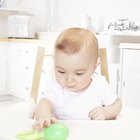Development of Depth Perception in Infants
A newborn's vision is not very acute or coordinated, though it improves over the next several months.
Depth perception, or a three-dimensional view of the world, develops between 5 and 8 months. This helps your infant identify edges and drops and determine which of two objects is closer.
Infant Vision Development
Newborns cannot tell the difference between two images or move their eyes between those images. A young infant can focus only on objects 8 to 10 inches from her face. During the next several months, her eyes become more coordinated, and vision quickly improves. By 8 weeks, an infant can start to focus on a parent's face or another close object. At about 3 months, an infant can follow moving objects with her eyes and reach for things in front of her face. Between 5 and 8 months, eye-body coordination improves, along with the development of depth perception and color vision. By 9 to 12 months, hand-eye coordination improves and an infant can judge distances.
Depth Perception and Crawling

Large Muscle Development in Infants
Learn More
The development of depth perception occurs around the time your infant might be starting to crawl. Depth perception is important when he crawls, as it is necessary for safety.
For example, an infant who has a three-dimensional view of his surroundings usually stops crawling at the edge of a dangerous drop-off, such as a flight of stairs. Of course, this doesn't mean that the infant doesn't need constant supervision to maintain safety. He may stop crawling at the top of the stairs, but he doesn't yet have the mobility and coordination to get down the steps safely.
Activities for Development at 5 to 8 Months
Allow an infant who is 5 to 8 months plenty of time to play on the floor and explore. Depth perception continues to improve as she crawls to objects at different distances. You also can hang a mobile or other objects across the crib. This helps your infant judge distances and fine-tune depth perception as she reaches out to grab objects.
Vision Problem Signs

How Does a Baby Rattle Help With Cognitive Development?
Learn More
Your infant can develop rare vision problems at any age that can interfere with normal vision progression.
Signs to watch for include excess tearing, eyelids that are red and crusted, continuous eye turning, a white pupil and extreme light sensitivity. See a doctor immediately if you notice any of these signs.











